#Final draft + Process Narrative 2
Explore tagged Tumblr posts
Text
🧩 How to Outline Without Feeling Like You’re Dying
(a non-suffering writer’s guide to structure, sanity, and staying mildly hydrated)
Hey besties. Let’s talk outlines. Specifically: how to do them without crawling into the floorboards and screaming like a Victorian ghost.
If just hearing the word “outline” sends your brain into chaos-mode, welcome. You’re not broken, you’re just a writer whose process has been hijacked by Very Serious Advice™ that doesn’t fit you. You don’t need to build a military-grade beat sheet. You don’t need a sixteen-tab spreadsheet. You don’t need to suffer to be legitimate. You just need a structure that feels like it’s helping you, not haunting you.
So. Here’s how to outline your book without losing your soul (or all your serotonin).
—
🍓 1. Stop thinking of it as “outlining.” That word is cursed. Try “story sketch.” “Narrative roadmap.” “Planning soup.” Whatever gets your brain to chill out. The goal here is to understand your story, not architect it to death.
Outlining isn’t predicting everything. It’s just building a scaffold so your plot doesn't fall over mid-draft.
—
🧠 2. Find your plot skeleton. There are lots of plot structures floating around: 3-Act. Save the Cat. Hero’s Journey. Take what helps, ignore the rest.
If all else fails, try this dirt-simple one I use when my brain is mush:
Act I: What’s the problem?
Act II: Why can’t we fix it?
Act III: What finally makes us change?
Ending: What does that change cost?
You don’t need to fill in every detail. You just need to know what’s driving your character, what’s blocking them, and what choices will change them.
—
🛒 3. Make a “scene bucket list.” Before you start plotting in order, write down a list of scenes you know you want: key vibes, emotional beats, dramatic reveals, whatever.
These are your anchors. Even if you don’t know where they go yet, they’re proof your story already exists, it just needs connecting tissue.
Bonus: when you inevitably get stuck later, one of these might be the scene that pulls you back in.
—
🧩 4. Start with 5 key scenes. That’s it. Here’s a minimalist approach that won’t kill your momentum:
Opening (what sucks about their world?)
Catalyst (what throws them off course?)
Midpoint (what makes them confront themselves?)
Climax (what breaks or remakes them?)
Ending (what’s changed?)
Plot the spaces between those after you’ve nailed these. Think of it like nailing down corners of a poster before smoothing the rest.
You’re not “doing it wrong” if you start messy. A messy start is a start.
—
🔧 5. Use the outline to ask questions, not just answer them. Every section of your outline should provoke a question that the scene must answer.
Instead of: — “Chapter 5: Sarah finds a journal.”
Try: — “Chapter 5: What truth does Sarah find that complicates her next move?”
This makes your story active, not just a list of stuff that happens. Outlines aren’t just there to record, they’re tools for curiosity.
—
🪤 6. Beware of the Perfectionist Trap™. You will not get the entire plot perfect before you write. Don’t stall your momentum waiting for a divine lightning bolt of Clarity. You get clarity by writing.
Think of your outline as a map drawn in pencil, not ink. It’s allowed to evolve. It should evolve.
You’re not building a museum exhibit. You’re making a prototype.
—
🧼 7. Clean up after you start drafting. Here’s the secret: the first draft will teach you what the story’s actually about. You can go back and revise the outline to fit that. It’s not wasted work, it’s evolving scaffolding.
You don’t have to build the house before you live in it. You can live in the mess while you figure out where the kitchen goes.
—
🛟 8. If you’re a discovery writer, hybrid it. A lot of “pantsers” aren’t anti-outline, they’re just anti-stiff-outline. That’s fair.
Try using “signposts,” not full scenes:
Here’s a secret someone’s hiding.
Here’s the emotional breakdown scene.
Here’s a betrayal. Maybe not sure by who yet.
Let the plot breathe. Let the characters argue with your outline. That tension is where the fun happens.
—
🪴 TL;DR but emotionally: You don’t need a flawless outline to write a good book. You just need a loose net of ideas, a couple of emotional anchors, and the willingness to pivot when your story teaches you something new.
Outlines should support you, not suffocate you.
Let yourself try. Let it be imperfect. That’s where the good stuff lives.
Go forth and outline like a gently chaotic legend 🧃
— written with snacks in hand by Rin T. @ thewriteadviceforwriters 🍓🧠✍️
Sometimes the problem isn’t your plot. It’s your first 5 pages. Fix it here → 🖤 Free eBook: 5 Opening Pages Mistakes to Stop Making:
#writing#writing advice#writeblr#writers on tumblr#writing tips#writing help#how to write#story structure#writing process#plotting tips#writing guide#writing blog#writing community#writing support#tumblr writing community#writing inspiration#storytelling tips#how to outline#writing resources#novel writing#outline tips#plotting a novel#writing craft#novel planning#write a book#drafting a novel#writing motivation#first draft advice#fiction writing#character arcs
2K notes
·
View notes
Text
Also... if Bumblebee somehow (and I mean this purely hypothetical) wasn't planned from the start and came about after Volume 5 as they allege, well, it fits like a damn fine glove.
After all, some elements of a story come about even when you're finalizing an absolute final draft. Like... has nobody heard about the story of Neo being introduced into Volume 2 just before the White Fang Rally was posted online? Imagine how different Volume Nine might've been without Neo.
If Bumblebee was a Neo type situation, they already laid the groundwork with Blake and Yang's friendship. Yang pleading Blake to believe she didn't maim Mercury. Yang charging in to stop Adam from hurting Blake and losing an arm. Yang very much being upset over Blake leaving and opening up to Weiss about it.
Even if they were meant to be initially "just good friends," that still lent itself as good set up for a romance to bloom. i've often found myself finalizing a story and seeing two characters hit it off in my eyes, convincing me that there's something more worth exploring.
That it wasn't there from the beginning doesn't make it inherently bad or worse.
Hell, most Manga is written by the seat of an author's pants. Even those with a solid road map of a narrative will often go, "Oh wait... what if... I added in this or that." Inspiration strikes anytime and anywhere.
Sorry to go off like that but the fact is that the creative process is a lot more complicated than how the RWDE likes to think it.
#bumblebee#bumbleby#rwby#rwby ships#rwby shipping#rwby volume 9#rwby volume 10#anti rwde#yang xiao long#blake belladonna#blake x yang#defense#stanning#bumblebee week#bumbleby week#bmblb#team rwby#storytelling#writing#writing by the seat of your pants#planning
95 notes
·
View notes
Note
How can I make my editing process quicker and less stressful? I feel like I’m spending way too much time on it and not really getting anywhere, so I’d love some tips on how to keep it simple and actually productive.
I think that most writers have a love/hate relationship with editing. It feels so good to see your manuscript go from a rough draft to something really polished, but at the same time, the editing process itself is painstaking and laborious.
The editing phase can feel like wandering through a maze without a map. Every writer has been there, staring at their manuscript, overwhelmed by the sheer amount of work ahead. But editing doesn’t have to be a source of stress. With the right approach, you can make your editing process both efficient and effective.
Break it down
While some writers thrive taking a do-it-all-at-once approach, this isn’t one that works for everyone. If you feel overwhelmed, you can try to divide your editing into distinct passes, each focusing on a specific aspect:
Story Structure – Focus on plot, pacing, and narrative flow.
Character Development – Examine character arcs and relationships.
Scene Level – Look at individual scene construction and transitions.
Language – Analyse word choice, clarity, and style.
Technical – Look at grammar, punctuation, and formatting.
By tackling one element at a time, you’ll catch more issues and avoid feeling overwhelmed. And you also don’t need to do them back-to-back.
When I do my first editing pass, I look at only story structure and character development. After draft 2, I look at a scene level analysis, with some attention paid to language. If I need to, I’ll repeat this for as many revisions as I need, leaving a deep-dive on language and the more technical proofreading aspects until my final draft.
Create a system
No two writers write alike. Your process will be as unique to you as the writing you produce, so never take someone else’s routine as gospel or as the only “right” way to approach it.
What you will need to do is experiment. Try different things. See what works for you, and what doesn’t. Things you can try might be:
Set clear goals
Before each editing session, define what you want to accomplish. For example:
“Review chapters 1-3 for pacing issues.”
“Check all dialogue in Act 2.”
“Analyse character motivations in transition scenes.”
Having specific targets can help give you focus and give a sense of progress, as it’s a task that you can tick off.
Track your progress
Monitoring your progress lets you actively see what you’re accomplishing. It can be a huge motivator when you can see your manuscript start to take shape.
Keep a spreadsheet of completed editing tasks.
Use a notebook to log issues that need addressing.
Create checklists for common problems you want to catch.
Track time spent on different editing tasks to identify where you might be getting stuck.
Organise visually
If you’re a visual learner, then being able to see your editing process taking shape can be a game changer. You could try to:
Highlight plot threads in different colours.
Mark scene transitions with clear breaks.
Flag areas that need deeper revision.
Use comments or sticky notes for bigger structural issues.
Create a colour code for different types of edits (dialogue, description, pacing, etc.).
Incorporate these colours into your tracking if you decide to use it.
Set a sustainable schedule
Editing can be just as time-consuming as writing (in some cases, it might be even more time consuming), so it’s important to make sure you don’t overwhelm yourself. Don’t expect your editing to be done in a week. To keep a routine that’s realistic and sustainable, you can try to:
Block out specific times for editing.
Set deadlines for completing different passes.
Build in buffer time for unexpected issues.
Schedule regular breaks to give yourself a fresh perspective.
Plan rewards for hitting milestones.
For me, the rewards are the biggest part of the process. I need that little serotonin bump when I finish something and give myself a treat. That can be anything from taking a break, to buying myself something. You can even involve a housemate or family member in the reward!
Keep reference materials handy
If you’re the kind of person who likes to remind yourself of the task at hand, then it can be uesful to keep reference materials or a style guide handy. This could include:
Your story bible or outline.
Character profiles.
Setting descriptions.
Style guide preferences.
A common error checklist.
Notes from previous drafts to make sure you don’t repeat mistakes.
You don’t need to have all references handy at all times. You can pick and choose what works for you, and what is important for that editing pass.
Know when to step back
Fresh eyes make better edits. If you’re tired or overwhelmed, there is absolutely no shame in stepping away. You’ll be much more productive if you approach editing when you’re not exhausted, because it’s very easy to miss things and get distracted if you’re not in the right headspace.
Make sure you take regular breaks between editing passes to maintain your perspective. And don’t be afraid to take a week or two away from your manuscript can help you return with renewed clarity. Read something else. Watch television. Just make sure you do something other than constantly working on your manuscript.
Get outside input
If you’ve done a few self-editing passes and feel you need to start polishing, you might want to look for outside help. This can take many forms. Some are free, while others will cost nothing more than your time. You’ll need to decide what is best for you. You can:
Share your almost-finished product with beta readers (I recommend you read this guide to get the most out of your beta readers, as they can be such a valuable resource).
Consider hiring a professional editor once you’ve done all you can.
Join a critique group for regular feedback during the drafting and editing process.
Find a writing partner for accountability and reciprocal labour.
Trust your instincts
Try different editing processes to see what works for you. Don’t try to force something that isn’t, and be willing to change tack if you need to. If something feels right, stick with it. If it doesn’t, let it go.
But no matter what editing process you choose to pursue, don’t aim for perfection in your first pass. Instead, focus on steady improvement through multiple editing rounds. With practice, you’ll develop a rhythm that makes editing feel less like a chore and more like a natural part of your writing journey.
#writeblr#writing tips#writing advice#writing resources#writing community#writers#writing#creative writing#writers of tumblr#creative writers#writerblr#writing inspiration#writing help#writblr#how to write#editing#editing advice#editing tips#editing resources#writer#writers on tumblr#ask novlr
68 notes
·
View notes
Text
Top 5 Writing Applications for Worldbuilding and Complex Story Planning
In the realm of creative writing, particularly when it comes to worldbuilding and complex story planning, having the right tools can make a significant difference. Writers often find themselves juggling multiple characters, intricate plots, and expansive settings. To manage these elements effectively, specialized writing applications have been developed to assist in organizing thoughts, tracking details, and fostering creativity. In this article, we will explore the top five writing applications that are indispensable for worldbuilding and complex story planning.
-_-_-_-_-_-_-_-_-_-_-_-_-_-_-_-_-_-_-_-_-_-_-_-_-_-_-_-_-_-_-_-_-_-_-
1. Obsidian: The Ultimate Tool for Writers
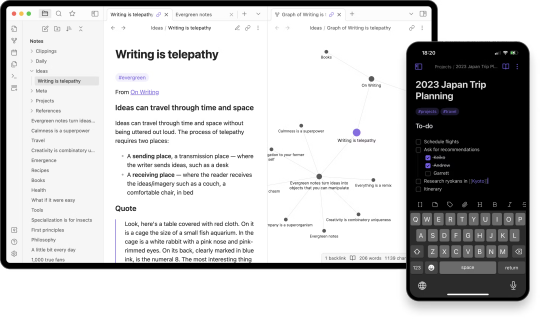
Obsidian is a robust note-taking and knowledge management application that has gained immense popularity among writers for its flexibility and powerful features. Whether you are working on a novel, a series of interconnected stories, or an entire fictional universe, Obsidian provides the tools you need to keep everything organized and easily accessible.
Key Features of Obsidian
Markdown Support: Obsidian uses Markdown, a lightweight markup language, which allows writers to format their notes with ease. This feature is particularly useful for creating structured documents and linking related notes.
Bidirectional Linking: One of Obsidian's standout features is its bidirectional linking capability. This allows writers to create connections between different notes, making it easy to navigate through complex storylines and character relationships.
Graph View: The Graph View in Obsidian provides a visual representation of how your notes are interconnected. This feature is invaluable for worldbuilding, as it helps writers see the big picture and understand how different elements of their story fit together.
Plugins and Customization: Obsidian offers a wide range of plugins that can enhance its functionality. Writers can customize the app to suit their specific needs, whether it's adding a calendar for tracking writing progress or integrating with other tools like Google Drive.
Cross-Platform Sync: With Obsidian, you can sync your notes across multiple devices, ensuring that you have access to your work wherever you go. This is particularly useful for writers who like to jot down ideas on their phone and then expand on them later on their desktop.
Pricing
Personal Use: Free
Commercial Use: $50 per user per year
Add-ons:
Sync: $4 per user per month, billed annually
Publish: $8 per site per month, billed annually
Catalyst: $25+ one-time payment for early access and VIP features
How Obsidian Enhances Worldbuilding and Story Planning
Obsidian's features are designed to support the intricate process of worldbuilding and story planning. The ability to create detailed notes for each character, location, and plot point, and then link them together, allows writers to build a comprehensive and cohesive narrative. The Graph View provides a visual map of the story, making it easier to identify connections and ensure consistency. Additionally, the customization options and plugins available in Obsidian mean that writers can tailor the app to their specific workflow, making it an indispensable tool for any serious writer.
-_-_-_-_-_-_-_-_-_-_-_-_-_-_-_-_-_-_-_-_-_-_-_-_-_-_-_-_-_-_-_-_-_-_-
2. Scrivener: The Writer's Swiss Army Knife

Scrivener is a well-known writing application that has been a favorite among writers for years. It offers a wide range of features designed to help writers organize their work, from drafting to final edits. Scrivener is particularly useful for long-form writing projects, such as novels and screenplays, where managing large amounts of text and research is essential.
Key Features of Scrivener
Project Management: Scrivener allows writers to break their projects into manageable sections, such as chapters or scenes. This makes it easy to navigate through the manuscript and make changes as needed.
Research Integration: Writers can import research materials, such as PDFs, images, and web pages, directly into Scrivener. This keeps all relevant information in one place, making it easy to reference while writing.
Corkboard and Outliner: Scrivener's Corkboard and Outliner views provide visual ways to organize and rearrange sections of the manuscript. This is particularly useful for plotting and structuring complex stories.
Customizable Templates: Scrivener offers a variety of templates for different types of writing projects, from novels to screenplays. Writers can also create their own templates to suit their specific needs.
Export Options: Scrivener supports a wide range of export formats, including Word, PDF, and ePub. This makes it easy to share your work with others or prepare it for publication.
Pricing
macOS: $49
Windows: $45
iOS: $19.99
Bundle (macOS + Windows): $80
How Scrivener Enhances Worldbuilding and Story Planning
Scrivener's project management features are ideal for worldbuilding and story planning. Writers can create separate sections for different aspects of their world, such as characters, settings, and plot points, and then easily navigate between them. The ability to import research materials directly into the project ensures that all relevant information is readily accessible. The Corkboard and Outliner views provide visual ways to organize and rearrange the story, making it easier to see the big picture and ensure consistency. Overall, Scrivener is a powerful tool that can help writers manage the complexities of worldbuilding and story planning.
-_-_-_-_-_-_-_-_-_-_-_-_-_-_-_-_-_-_-_-_-_-_-_-_-_-_-_-_-_-_-_-_-_-_-
3. Campfire: A Comprehensive Worldbuilding Tool
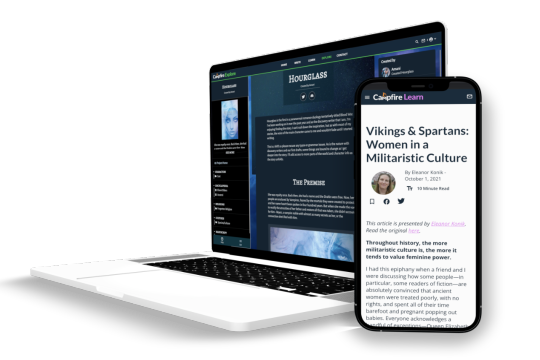
Campfire is a writing application specifically designed for worldbuilding and story planning. It offers a wide range of features that allow writers to create detailed and immersive worlds, from character profiles to interactive maps. Campfire is particularly useful for writers who are working on large-scale projects, such as epic fantasy series or intricate science fiction universes.
Key Features of Campfire
Character Profiles: Campfire allows writers to create detailed profiles for each character, including information on their appearance, personality, and backstory. This helps ensure that characters are well-developed and consistent throughout the story.
Worldbuilding Tools: Campfire offers a variety of tools for worldbuilding, such as interactive maps, timelines, and relationship webs. These features allow writers to create a comprehensive and cohesive world for their story.
Plotting Tools: Campfire's plotting tools help writers outline their story and track the progression of the plot. This is particularly useful for complex stories with multiple plotlines and subplots.
Collaboration Features: Campfire allows writers to collaborate with others on their projects. This is particularly useful for co-authors or writing teams who need to share information and work together on the story.
Customizable Templates: Campfire offers a variety of templates for different aspects of worldbuilding and story planning. Writers can also create their own templates to suit their specific needs.
Pricing
Free Plan: Limited features
Standard Plan: $19 per month or $160 per year
Custom Plan: Prices start at $0.50 per month per module
How Campfire Enhances Worldbuilding and Story Planning
Campfire's features are specifically designed to support the process of worldbuilding and story planning. The ability to create detailed character profiles and interactive maps allows writers to build a rich and immersive world for their story. The plotting tools help writers outline their story and track the progression of the plot, ensuring that all elements of the story are well-organized and consistent. The collaboration features make it easy for co-authors or writing teams to work together on the project. Overall, Campfire is a comprehensive tool that can help writers manage the complexities of worldbuilding and story planning.
-_-_-_-_-_-_-_-_-_-_-_-_-_-_-_-_-_-_-_-_-_-_-_-_-_-_-_-_-_-_-_-_-_-_-
4. Aeon Timeline: A Visual Timeline Tool for Writers
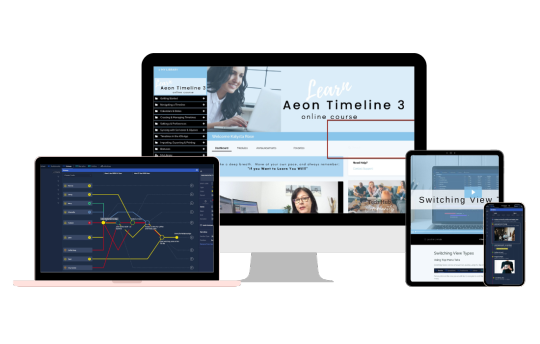
Aeon Timeline is a visual timeline tool that helps writers organize their stories and track the progression of events. It is particularly useful for complex stories with multiple plotlines and characters, as it allows writers to see the big picture and ensure consistency.
Key Features of Aeon Timeline
Visual Timelines: Aeon Timeline allows writers to create visual timelines for their stories, making it easy to see the progression of events and track the relationships between different plotlines.
Character and Event Tracking: Writers can create detailed profiles for each character and event, including information on their relationships and interactions. This helps ensure that all elements of the story are well-organized and consistent.
Customizable Templates: Aeon Timeline offers a variety of templates for different types of writing projects, from novels to screenplays. Writers can also create their own templates to suit their specific needs.
Integration with Other Tools: Aeon Timeline integrates with other writing tools, such as Scrivener and Ulysses, making it easy to import and export information between different applications.
Collaboration Features: Aeon Timeline allows writers to collaborate with others on their projects. This is particularly useful for co-authors or writing teams who need to share information and work together on the story.
Pricing
One-time Purchase: $65 (includes 1 year of free updates)
Additional Year of Updates: $35 per year
How Aeon Timeline Enhances Worldbuilding and Story Planning
Aeon Timeline's visual timeline feature is particularly useful for worldbuilding and story planning. Writers can create detailed timelines for their stories, making it easy to see the progression of events and track the relationships between different plotlines. The character and event tracking features help ensure that all elements of the story are well-organized and consistent. The integration with other writing tools makes it easy to import and export information between different applications, ensuring that all relevant information is readily accessible. Overall, Aeon Timeline is a powerful tool that can help
-_-_-_-_-_-_-_-_-_-_-_-_-_-_-_-_-_-_-_-_-_-_-_-_-_-_-_-_-_-_-_-_-_-_-
5. Plottr: Visual Story Planning Made Simple

Plottr is a visual story planning tool that helps writers outline their stories in a clear and organized manner. It is particularly useful for writers who prefer a visual approach to planning and want to see their story structure at a glance. Plottr's intuitive interface and powerful features make it an excellent choice for both novice and experienced writers.
Key Features of Plottr
Timeline View: Plottr's Timeline View allows writers to create a visual timeline of their story, making it easy to see the sequence of events and how they fit together. This is particularly useful for complex stories with multiple plotlines.
Character and Plot Templates: Plottr offers a variety of templates for character development and plot structure. Writers can use these templates to ensure that their characters are well-rounded and their plots are cohesive.
Drag-and-Drop Interface: Plottr's drag-and-drop interface makes it easy to rearrange scenes and chapters. This allows writers to experiment with different story structures and find the one that works best for their narrative.
Filtering and Tagging: Writers can use tags and filters to organize their scenes, characters, and plot points. This makes it easy to find specific elements of the story and keep track of important details.
Export Options: Plottr allows writers to export their outlines to other writing applications, such as Scrivener and Word. This makes it easy to move from planning to drafting without losing any important information.
Pricing
Annual Plan: $25 per year
Lifetime Plan: $99 one-time payment
How Plottr Enhances Worldbuilding and Story Planning
Plottr's visual approach to story planning makes it an invaluable tool for worldbuilding and complex story planning. The Timeline View allows writers to see the big picture and ensure that their story flows smoothly. The character and plot templates help writers develop well-rounded characters and cohesive plots. The drag-and-drop interface and filtering options make it easy to organize and rearrange story elements, ensuring that nothing gets lost in the process. Overall, Plottr is a powerful and user-friendly tool that can help writers bring their stories to life.
-_-_-_-_-_-_-_-_-_-_-_-_-_-_-_-_-_-_-_-_-_-_-_-_-_-_-_-_-_-_-_-_-_-_-
Each of the applications we’ve explored - Obsidian, Scrivener, Campfire, World Anvil, and Plottr - offers unique features that cater to different aspects of writing. By integrating these tools into your workflow, you can unlock new levels of creativity and efficiency.
Are you ready to take your writing to the next level? Dive into these applications and discover which one resonates with your creative process. And don’t forget to follow us for more insights, tips, and recommendations on the best tools and practices for writers. Your next great story is just a click away!
#writing#writerscommunity#female writers#writers and poets#worldbuilding#writers on tumblr#ao3 writer#amwriting#creative writing#writers on writing#writers#writblr#learn to write#writing community#writing inspiration#writing prompt#writing advice#writing ideas#writing tips#tips and advice
151 notes
·
View notes
Text
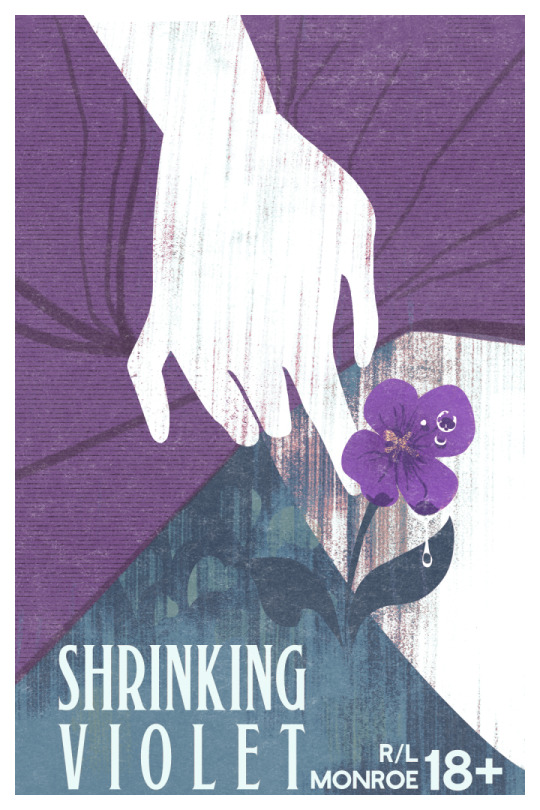
Shrinking Violet is out! another of @petitemortality R/L Monroe's wonderful erotic shorts, with another cover by yours truly >:) i've been saying it on nearly every promo post i make for this but if you're one of the people who has wanted me to write f/f, you're legally obligated to read this one. below is the sales copy, and then below that some discussion of the process for designing the cover!
Nobody at college knows that shy, nervous Maya had a 'bad boy' reputation in high school - and Maya is the only one who knows tough, rebellious Nasrin used to be a sweet-tempered teacher's pet. Mutual attraction is rekindled when their paths cross again, but the two find their old dynamics have been flipped on their head. Maya finally knows what she wants, and Nasrin is bold enough to give it to her...that is, if she can bring herself to ask. Will their first time be perfect the second time around? 7k words, EPUB and PDF format. This is the second in the Fuck Yourself Friday series of shorts. New stand-alone erotic stories are released on the last Friday of every month. FYF 1: Go Fuck Yourself These stories contain explicit sexual content, and are intended for 18+ audiences.
Contains: -F/tF -transfem sub -outdoor sex -praise kink -soft penis stimulation -non-penetrative sex
THUMBNAILS
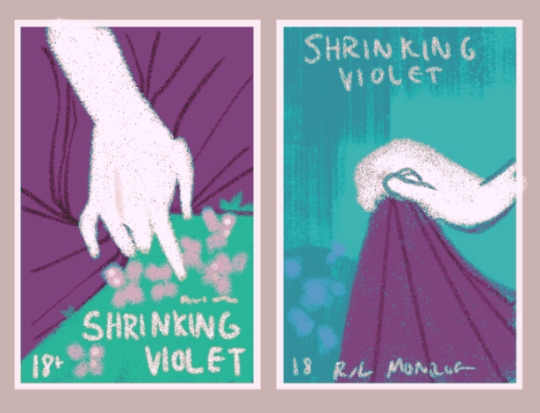
this one was very straightforward with the request: "the image I have in my mind for a cover is someone's fingers knotted in a skirt spread out against wildflowers. but more in the sort of gripping your own skirt gently kind of way, somewhere between anxious and excited if that makes sense. I'm thinking like you know the classic soft grunge tumblr aesthetic photo vibe. type of shit you'd post next to a closeup of a skinned knee in long socks"
very easy instructions to follow! so while i usually prefer to do 3 thumbnails, i only ended up with 2. there's only so many ways you can depict a hand on a skirt, after all. and we decided that we wanted to continue with the style i established with the first one, with silhouettes, lineless art, and bold textures. we liked the first one more, but wanted to get some leg in there.
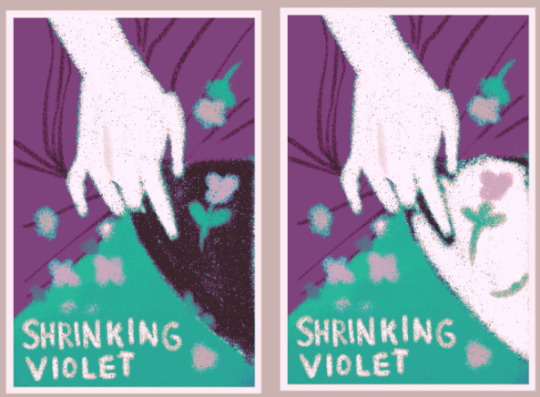
i proposed adding black pantyhose to the narrative to make it work on the cover (i have changed prose to match what i drew for illustrations Many times) but we went with bare leg in the end
FINISHING

so i didn't actually do a sketch for this one, just went straight to rendering. as we all know i use gradient maps a lot in my work, so i gave lee a choice between a bright, springy palette, and a wetter, darker palette. i also offered it with the border, or with the skirt going over it. personally i like the skirt going over it, but the border keeps it consistent and more book-cover-y, so we went with that. lee chose the darker palette, which suits the story much better
but the font didn't fit! too vintage for the story, which takes place in modern day.
fonts time :^)
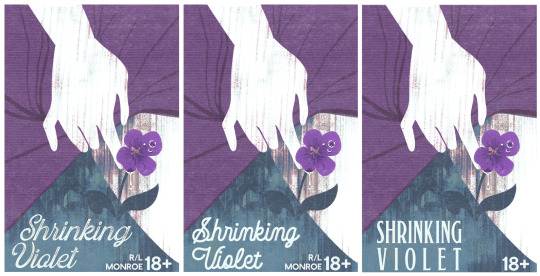
we went with the third option for the contrast. and also added a raindrop to the flower (which got moved to the right petal in the final draft). gently touching petals, wetness, This Is Yuri.
and the final result is as above!
anyway you should all read this story, it's incredibly sweet childhood-best-friends-to-lovers and in itself a love letter to trans femininity. i highly recommend it, and it's only $3!
go and get it!
69 notes
·
View notes
Note
hello my lovely, I hope you’re doing well !! 💗💗 I was looking to ask you for some writing advice today :) how do you get your concept from the outline, to writing the actual story?
I’m a very visual person/learner (like i’ll struggle with verbally giving instructions, it’s easier for me to just show how instead) and I think that’s what stumps me when it comes to writing ;_; I can jot down the ideas and like write out the plot easily in summary form, but when it comes down to actually bringing that concept to life and start telling the story, I freeze on how to go about it :’) I know I say this a lot but…I do hope i’m making sense 😅
i still wouldn’t really consider myself a writer, (I feel like I have imposter syndrome if I do lol) but I am currently working on my story for your summer writing challenge (💙) and alsooo a mark meachum fic 👀 not sure yet, i’m just obsessing over him so much rn and the story idea will not leave my mind, my brain just keeps adding and adding on to it 😭 the newest episode only contributed to this, lmao


Hello my lovely friend!! 💜💜 Ooh, this is a great question, because you're certainly not alone. This can always be a struggle for writers, myself included.
How do you get your concept from the outline, to writing the actual story?
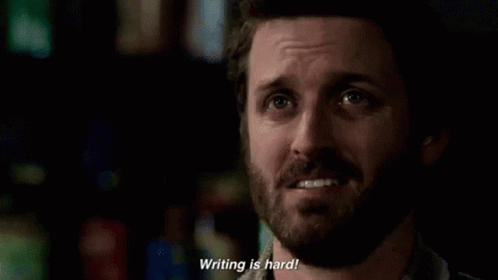
I'll tell you my process, but honestly this looks different for everyone. I love that you're a visual learner, because I am too. I need to be able to see it in my mind's eye when I'm writing, like the scenes of a movie.
So that's how I think of writing. Like a movie in my head! 😆
Here's my writing process in 5 basic steps:
1. Character Bios
Before I even create an outline for a long-form story, I'll typically I start with the most basic part of the puzzle: who are the characters?
Main characters only to start with, bulleted with short character descriptions of who they are and what their arc will be in the story.
2. Summary & Storyboarding Structure
Summarize the story as a whole in 1 paragraph. If you can do this, then you can start to break it down into outline, and then draft.
Because you're so visual, it could also help you to conceptualize the story into a basic 3-act structure, like we study in classic narrative:
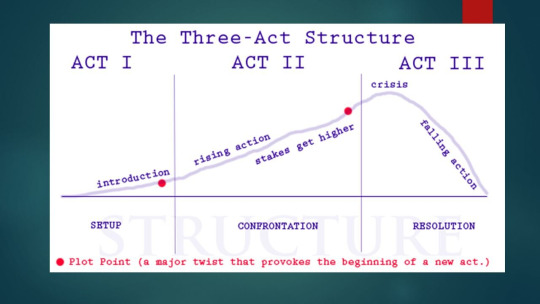
(Another resource (with a video) for 3-act structure here.)
But yeah, like I've literally taken out a notebook and drawn this by hand and filled in details to help myself visualize a plot.
There are also other types of narrative structure that you can explore here. (Joseph Campbell's Hero's Journey is my personal favorite.)
⟡ My ultimate favorite writer resource is Save the Cat by Blake Snyder and his Beat Sheets. Storyboarding/mapping out your story like this can be really helpful if you're a visual storyteller.
3. Outline
The way I beat writer's block is by having a map of where to go. The outline is that map, of course, but I'm also a very detailed mapper. I go chapter by chapter, scene by scene, even including dialogue for a scene if it comes to me in the moment.
I can always change, finesse, add, subtract things later, especially as I'm drafting, but this initial pounding out of the notes on the keyboard is really important for me.
I also need to go in order. I can't start from the middle or the end. I have to go beginning to end, like sheet music, or like that movie in my head. I need to know what my characters' motivations are for their decisions in every scene, or else the story itself can't move forward.
(If I have an idea for the ending or a concept I want to explore in future chapters, I'll jot it down as a bullet point (or more) at the top of the page so I don't forget it. Then I inject that bullet in later when I finally get to that scene in the outlining process.)
While I'm outlining, I'm doing any necessary research to fill in story gaps and background. This takes a lot of the pressure off while drafting.
4. Drafting
As you can see, my outlining process is almost "half-drafting." That way, by the time I get to the actual writing part, at least 40% of my struggle is already dealt with.
That's not to say I don't have "aha" moments, or stumbling blocks, or moments that I have to go back to the drawing board, or dig deeper into research while drafting. But the flow of writing each chapter is easier because I can already see so much of the narrative in my head.
5. Editing
This is actually my favorite part. 😂 Maybe because I'm an editor professionally, but I actually, truly love the editing process.
This is where I fine tune those lines of dialogue, sharpen the back and forth between characters, finesse the tone or flow or sequence of scenes, fill in the basic descriptions with more poetic lines, etc. This is where I feel like I truly find the soul of the story.
⟡ If you think your opening scene isn't strong enough: Consider why we're starting here, in this scene, in this moment in time. Think of your favorite movies or books with a similar storyline or trope. Would it be more compelling to start in the middle of the action? In a quiet moment? In a flashback? In a flash-forward (some point in the future)?
⟡ If you're struggling how to end your story: What has the main character (or characters) learned by the end of this story? What did they want at the beginning? Has that changed by the end?
What do you want to leave your audience contemplating? Do you want to leave room to make their own conclusions about an ending, or do you want to take a firm stance on how these characters end up?
What does this say about the main theme of the story overall -- and how does it reflect an aspect of life, and the human experience?

i still wouldn’t really consider myself a writer, (I feel like I have imposter syndrome if I do lol) but I am currently working on my story for your summer writing challenge (💙) and alsooo a mark meachum fic 👀 not sure yet, i’m just obsessing over him so much rn and the story idea will not leave my mind, my brain just keeps adding and adding on to it 😭 the newest episode only contributed to this, lmao
Hey, if you're doing any part of the 5 things above, then you're writing. You're doing the thing. Therefore, you are a writer. You're just young in experience.
The great thing about writing is that you keep learning through practice, through trial and error. And trust, I still have moments where I doubt myself and think:
"Aw shit, this isn't as good as other people's work."
"What am I even doing? This is hot garbage."
"Ugh. I was proud of this, but now I kind of hate this."
But after I take a break from it for a little while -- go for a walk, rewatch something for inspo, listen to some music that fits the vibe or the message of the story I'm trying to tell -- I try my best to get back into the story and finish what I started, and figure out how I can believe in the thing I'm writing again.
I'm sooo excited that you want to write for Mark!! He's giving me so much new creative life too right now loll. When those ideas spark and snowball on you, you know it's worth exploring. I truly hope these tips help you start cooking, friend, because I can't wait to read it! 😍💗💗
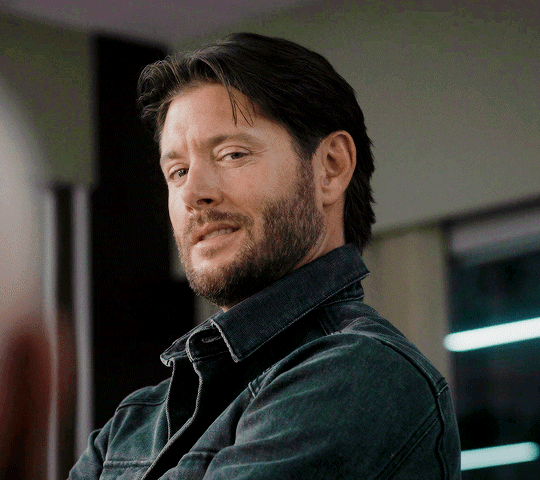
#ask me stuff#5-Step Writing Process#writing process#lovely mutuals#Zepskies 5K#writer's block#writers#writing stuff#countdown#jensen ackles#jackles#supernatural#spn#spnfandom#countdown fanfiction#mark meachum fanfiction#writing tips#writing community#writers on tumblr#writing advice#mark meachum#zepskies answers
6 notes
·
View notes
Text
On keeping a short story short
Today is release day on all other ebook platforms for my new novella! Woo!
And since Tell Me How Long is a novella, I thought I’d talk about the process, and how it wasn’t always meant to be so short. This is not for drabbles or ficlets and one-shots, but somewhere between 15-30k words.
—
I do not write short stories outside of fanfic, and I only write short fanfics (5-30k words) because I don’t have the attention span to stick with writing someone else’s characters anymore. Odds are, if I don’t hammer out the entire 30k word fanfic in one/two sittings, I’m never going to finish writing it.
And fanfic is where my new novella came from, or at least the fanfic mindset. I had writer’s block so I pulled some characters from an existing WIP of mine and tossed them into a new setting for fun to still keep writing.
This is also how my debut novel started but that blew up from “I’ll try to keep this at an 80k word one-off” to “wait hold on I can make this a trilogy” to “wait wait to tell this story properly it needs to be a quadrilogy”.
Short original fiction really isn’t my thing.
My new novella only remained a novella because I hit the 30k word plateau, got bored, and put it away for a long time, a couple years. But the thing is, every so often I’d go back and I’d reread my favorite scene from it and think “damn I wrote this? It was so good!”
And after all the work and hype of getting my first novel out after a 7-month sprint start to finish, I’d immediately rushed in to the sequel, figured out that my book 2 plot has to shift entirely to book 3, and my “deleted scenes” is one again far longer than the narrative I have working.
So. I went back to my little unfinished fanfic. And thought, ‘let me spread this around and just see if these first few parts is compelling enough to continue.’
And the feedback I got back was that the part I had already edited was good enough to stand on its own, with some reworking of the ending.
All my hazy plans of giving the characters full arcs and time to develop and drama, angst, possibly even romance, got axed.
What I ended up with in the final draft is 22k words, with eight core characters, 3 of which do not speak. There was no time to give anyone except the MC an in-depth arc, no time for side-plots, no time for anything except what was immediately happening along the primary storyline.
…and I really like it? It’s not overcomplicated with layers of narrative, but it is packed with thematic depth, stand-out character beats, as much personality as I could cram into 8 characters, only one of which is present for all six chapters.
It is a very lean story, but it’s exactly what it sets out to be.
The thing is that short fanfics have the advantage of not needing setup and establishment of characters and relationships, when it’s already in the canon. Short stories can’t be that complex in plot when time has to be spent making the reader invested in the characters, first.
Short stories can be 20k words of fluff… but I recently read one that was exactly ~35k words of fluff and I kept waiting for it to get more interesting or complex or tell me something substantial about the world and characters and it just didn’t. It absolutely read like a cliche fanfic of the author’s pre-existing characters from a much better and bigger story, not something worth buying separately with real money.
So here's some things to consider, while recognizing that the diversity possible within a short story’s premise is virtually limitless. These are just things that I was thinking about when revising what I thought was going to be ⅓ of a whole book into its own thing.
Nearly every single scene is focused on something new. It’s a very small setting for 4/6ths of the story—one research boat—but characters never retread old points of conversation. The ongoing ethics debate keeps evolving, and even when the placement of characters is stagnant, what they’re doing is always changing, so the story keeps progressing very quickly.
Having 3 non-speaking characters meant I could justify having the audience know very little about them. Since they were limited to rudimentary Sign and drawings, every single one of their lines had to be important information. Zero room for fluff and wasted effort when it takes them so much effort to communicate.
There may only be an A Plot that every character is working toward, but it is still multifaceted. A plot being: We need to save this sick mer.
In the background, there’s the ethical dilemma participated in by all speaking characters. There’s the MC’s frustrations over the world’s apathy toward saving the oceans. There’s getting to know the other mer characters. There’s teaching the other mer Sign and written word. There’s the threat of discovery, the actual medical efforts and tension over whether they’ll succeed, and some questions that characters have had unanswered for years. Not a single paragraph is wasted and every single scene relates to the main theme in some way.
In many ways, it’s written with the same mindset that I’d approach a massive 100k word novel, but missing any consideration for the world beyond the immediate conflict. I don’t even have a villain, only time, nihilism, and insufficient medicine.
So if you’re like me, and you can’t help but make long epics and keep coming up with new subplots, new conflicts… try your hand at something that forces you to be efficient, doing as much as possible with as little words as possible, and you might surprise yourself.
—
If you’re not friendly with Amazon, here is every other ebook platform I’m able to list it on at this time. Including: Kobo, Barnes & Noble, Everand, Thalia, Smashwords, Angus & Robertson, Vivlio, Palace, and Fable.
#writeblr#writing#writing a book#writing advice#writing resources#writing tips#writing tools#book release#book launch#ebook#novella#short story
12 notes
·
View notes
Text

Big Bang Etiquette: Tips for Writers & Artists Working Together
Sometimes it feels daunting to start talking to someone you don’t know on the other side of the world, particularly if you’re a little shy. Here are some tips to make your Big Bang experience fun and productive!
After all, it’s in everyone’s best interest to finish the fic and artwork. So we have tried to come with a handy guide. Hope this helps you!
For Writers:
1. Be Clear with Your Vision: Share your story ideas early. Let your artist know about key scenes or vibes that inspire your work.
REFERENCES, REFERENCES, REFERENCES: These are key to make sure that the artist understands what you are envisioning.
Pinterest boards can also be your friend.
Share your outline and your chapters as soon as possible so that the artist can start planning!
2. Respect Artistic Freedom: Trust your artist’s interpretation. Their unique perspective adds depth to your story.
Be Open to Surprises: Your artist may come up with ideas or visual elements you hadn't considered. Embrace their creativity as it often leads to a richer final product.
Constructive Criticism: If you’re unsatisfied with a piece, don’t be scared to speak up, but do so respectfully. Frame your feedback in a way that’s encouraging and helpful, like suggesting adjustments instead of outright rejections.
3. Deadlines Matter: Stick to agreed timelines. Your artist is working around them too!
Plan Ahead: Keep track of all deadlines and set internal checkpoints to ensure progress is on track. If you anticipate delays, communicate early to find a solution together.
Be Reliable: Consistent and timely updates build trust and show your commitment to the partnership. If you meet your deadlines, your artist is more likely to do the same.
For Artists:
1. Ask Questions: Don’t hesitate to seek clarification on characters, settings, or moods. A little detail can spark the perfect illustration.
Dig Deep: Ask about character motivations, the tone of scenes, or any specific visual details the writer envisions. Even small things like the color of a character’s eyes or the style of clothing can make a big difference.
2. Share Progress: Show sketches or drafts early on. Feedback from the writer can steer your work in the right direction.
Step-by-Step Updates: Share your progress in stages—initial sketches, line art, color blocking, etc. This allows the writer to give feedback at each step, preventing major overhauls later on.
Encourage Input: Invite the writer to share their thoughts openly. Remind them that it’s easier to make changes during the sketch phase than in the final stages.
3. Be Flexible: Sometimes the story evolves. Adapt if needed and stay open to adjustments.
Offer Solutions: If a requested change seems challenging, suggest alternatives that stay true to the writer’s vision but might be easier or more effective artistically.
4. Respect the Story: Your art enhances the writing. Keep the narrative in mind and aim to complement the writer’s vision.
Stay True: Your art should reflect the mood and style of the story. Whether it’s lighthearted, dark, whimsical, or intense, align your artistic choices with the writer’s narrative goals.
For Both:
Communicate Regularly: Check in often, even if it’s just to say everything's on track.
Be Considerate: Life happens. If something’s going off course, let your partner know ASAP.
Celebrate Each Other: Acknowledge each other’s efforts. This project is a team effort—cheers to collaboration!
Ways To Get Conversation Flowing:
1. Artist
Ask the writer what inspired the story or how they come up with ideas
Tell the author your favourite scenes. The creation process takes a long time, and some writers miss getting the in-flow of kudos and comments from Ao3 for motivation. During this phase, you are their source of motivation!
2. Writers:
Ask why the artist why they liked your idea.
Tell them about yourself, anything from the Timezone you are in to help with communication or to what inspires you.
If you have something big coming up, like a holiday or an exam, let your artist know. Who knows you might find out you have similar interests!
3. Both:
Talk about anything and everything! Compare head canons, your favorite episodes, maybe even your favorite fics!
Provide regular updates! Ask for feedback. It doesn’t have to be a complete work. You’re just providing each other reassurances that there’s progress!

Remember this is more than an event, this is FANDOM! And we are here to have fun and make new friends!
#big bang etiquette#big bang#fandom event#tips for working together#collaboration tips#ml big bang 2024
22 notes
·
View notes
Text
Non-Stop
As someone who likes to dabble in the art of writing, there is something to be said of the process in and of itself. Like many, I've often wished for the ideas circulating in my head to appear on the blank Word document fully formed. A novel come to life before my very eyes. Instead, I often myself chained to my desk, pecking out words and then scratching them out and coming up with a whole new sentence to describe the exact same thing. Except bigger. And better. And more readable.
Writing, it should be universally acknowledged, is no small feat. Especially for someone who holds down a full-time job (which is completely unrelated to my dreams of becoming a bestselling author), has a myriad of other hobbies, and also wants to squeeze in some social interactions with my friends during the week.
And yet...
Were I trapped in the Dark Place, hammering out my words in a bid to escape, I wonder what sort of narrative I would spin. Fantasy has always been my go-to genre as both a writer and a reader. But as some of the short stories I've provided on my blog can attest, I am no stranger to other genres. And if I'm being constrained by the Dark Presence's emphasis on grim and dark emotions, why, I think I might churn out fantasy horrors a la T Kingfisher.
How they might lead me to freedom is a mystery although I imagine there will be swords aplenty. Maybe I'd write in a local LARPing group coming to my rescue instead of a federal agent.
One can only dream.


All of this, though is to say I've just finished playing the latest in Remedy's catalogue: Alan Wake 2. This game released on the tail end of 2023 and takes place thirteen years after the first. For many, its announcement came as a surprise, although there had been some teasing threads in Remedy's previous game: Control. Despite having no physical copy available, I was still eager to try it out. Alas, with the slew of video games I had to get through, it was not until the end of 2024 that I was able to enjoy my time with the narrative brought about from the creative mind of Mr Sam Lake himself.
Just to shake things up, however, let's start with the gameplay. Why, I hear you ask? Well, there's a lot to unpack with the narrative. Especially with the symbolisms present within. So, you'll forgive me for wanting to discuss it afterwards.
Alan Wake 2 is a third-person shooter that plays like many a horror game: resources are scant and there are jump scares every few minutes to keep one on their tones. Of course, these jump scares are mostly prevalent when tackling overlaps. But what disconcerted me the most was how these were all live-action. Thankfully, though, the game wasn't too terrifying for me. The music cues helped in preparing myself for what might happen next even as it had me looking around every corner as it helped build up the atmosphere.
From a combat perspective, Alan Wake 2 expands on the first game. Yes, you still shine your torch and then shoot the Taken but there are now a myriad of weapons and other tools at your disposal. Saga and Alan are also able to duck away as the enemies take a swing. Yet, I'd have to say the game is also quite a bit harder than the first. Especially when Saga or Alan are overwhelmed by foes. These were few and far between but it was enough that during the Final Draft playthrough, I put the difficulty down instead of making it harder.
The other gameplay aspect of the game I liked was how different Saga and Alan played. While their loadouts are similar, they each have their own respective upgrade and ability system. But what stood out to me was how the different characters had access to a unique menu to assess the information the game presents. Saga used a mind palace and often utilised a case board or profiling to help solve the murders plaguing the town of Bright Falls. Alan, on the other hand, thinks very much like a writer. In his mind, he has a plot board to the side where he can brainstorm the ideas he stumbles upon and change the scenes of the story he's in. Doing so impacts the immediate environment, an important factor allowing Alan to progress through his chapters.


Now here comes the bit where I try to analyse the shit out of the game.
Alan Wake 2 begins with Saga Anderson, an FBI agent, arriving at Cauldron Lake following the discovery of the body of former agent Nightingale. The man had lurched out from the lake and was then murdered by masked cultists. Or so it was believed. Later, at the morgue, Nightingale returns to life and takes out several officers before escaping.
It soon becomes clear something supernatural is happening. Saga soon finds a manuscript page from a new novel: Return. Seeing how the words change the world around her, she puts her faith in the writing and sets out to Cauldron Lake. And like the traditional hero, she follows the plot beats as set out by the story. Along the way she uncovers more of her family history, figures out the true mastermind behind the Cult of the Tree, and tangles with corrupted forms of the local townsfolk. All culminating in a final confrontation with the Dark Presence where the other hero, Alan Wake, pays the ultimate price.
Alan's story sees him trapped in the Dark Place, looking for an escape. The way he does so? By writing. This allows him to project out of the writer's room he is trapped in and navigate a gritty and dark version of New York. There, he tangles first with talk show host: Warlin Door, where it is revealed he has written a sequel to his seminal piece from the first game: Initiation. However, Alan has no memory of ever penning the piece.
Fearing for his mind, he manages to escape out into the streets of New York. His first order of business? Finding a murder site so he can then transport himself back to Parliament Tower where his wife is.
Once he does enter his apartment, he finds another manuscript entitled Return. Another story he does not remember ever writing. Before he can contemplate the piece further, the Dark Presence catches up with him and Alan wakes again in his writer's room.
Thus he returns once more to his story, projecting himself back into the fake New York to find a way out of the Dark Place once and for all. During one such loop through, Alan partakes in a wild and chaotic musical: The Herald of Darkness. But always, the set route he takes follows the same rhyme. Like most writers, Alan is a creature of habit and he follows the rules of three to bring him ever closer to solving the mysteries he no longer remembers.


In the Dark Place, Alan muses, time loops. And while there are slight variations, it inevitably brings him back to the beginning where he must try again.
This, in and of itself, is important when it comes to discussing the themes of the game. I think it obvious that the Dark Place is a stand-in for depression. Of being at rock bottom.
Alan's journey, unlike Saga, is about trying to claw his way out. Of escaping the cycle he finds himself in.
For most people suffering from depression or mental illness, it can often feel like you take one step forward and two steps back. Progress can easily be obscured by backsliding. Especially during crucial moments.
There is no concept of time when you're depressed. Emotions are raw. Memory, too, is unreliable.
Yet, as we all know, the tortured artist is the one who can present to us, the audience, the most exquisite of works. Think Vincent Van Gogh or Sylvia Plath. In the Alan Wake videogames, our tortured artist here is Alan Wake himself. Tormented by his own words and living a tormented life trapped in the Dark Place, how could he not be the quintessential trope we all know and love?
The way the game plays with the use of light and darkness, too, further echoes these themes. In the Final Draft, the presence of Alice helps break Alan out of the spiral he finds himself in and he is able to ascend out.
His characterisation contrasts with Saga. She has a loving family and a support network. When she is trapped in the Dark Place at the end of the game, she shows her resilience by putting the self-doubt and negative self-talk on hold. Instead, she is able to focus on the positives in her life and in the evidence she has around her that proves she is more than what the critical inner-voice would have her believe. Saga, too, quickly realises that it is her own anxiety and fear preventing her from leaving. By tackling it head-on, she is able to find her way to the exit.
Something which Alan struggles with as his only way of finding an escape is to use his art as a means to rationalise the negative emotions he feels.
It is these elements that make Alan Wake 2 stand out as a piece of media. Yes, it has its own absurd Finnish deadpan humour too (especially in the Night Springs DLC) but the primary story being told here is one mans' struggle with mental illness and navigating his way out. Focused solely on his own determined path out, Alan fails to acknowledge the other ways he can escape (as an aside, he does write the Lake House DLC addendum, but it feels like an attempt to use features in Bright Falls to better add to the worldbuilding of the world he has created in Return). Nor does he ponder the factors that brought him to the Dark Place in the first place.
The ending, too, even during the Final Draft also felt open enough for further entries. Especially with Alice's status still unknown. And while Alan does seem to be in a better headspace at the end (like when he was finally freed of the Dark Presence at the end of Chapter Seven of Return), it's anyone's guess if he might still fall back onto old patterns.
Let's just hope it doesn't take Alan another thirteen years to push out the ending he deserves. Perhaps he needs a little of the Brandon Sanderson magic to pull him out of his slump?
On a completely unrelated note, is it me or does Sam Lake seem to be having the time of his life? As both the creative lead and the writer, he sure enjoys inserting himself into his own games. Even playing the role of Alex Casey and doing the 'Max Payne' scrunch face. Not to mention the short film Yoton Yo!
By the way, Mr Sam Lake, it's okay if you want to set the game in Finland. I'd still play it. America is too saturated a setting!
Also, if you want to pursue other artistic forms, I'm also down.
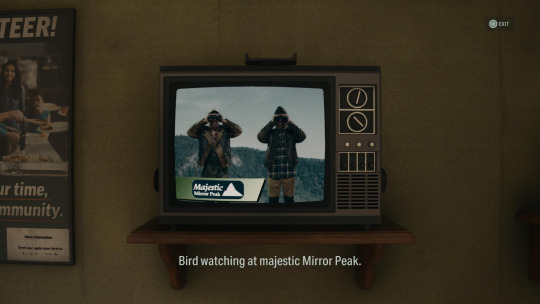
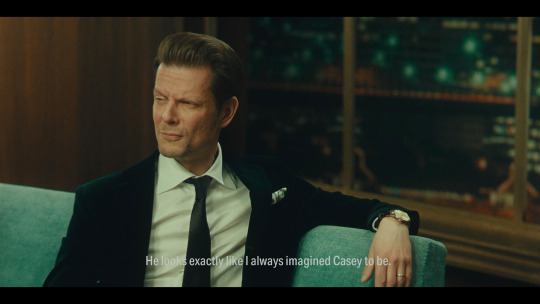
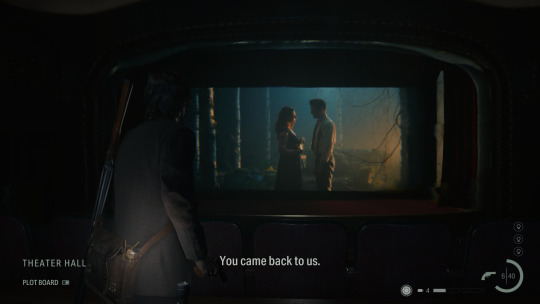



#alan wake 2#video games#saga anderson#alan wake#dark presence#dark place#alex casey#why do you write like you're running out of time#how do you write like you need it to survive?
7 notes
·
View notes
Text
on the fall
today, I have posted the last chapter of the fall. As I mention in its final notes, this story found its first inception as a series of notes written in December of 2022. It is now May of 2025.
You may know that, if you’ve followed by work for long enough is so entirely out of character that this is a genuinely singular pace. Unless I am prewriting the fic, or noting it’s ideas down for a later point—the prior being incredibly rare, now, with me not having the patience to write all of a multi chapter fic before posting anymore—the fic writing process, from inception to first release SELDOM takes more than 2-3 months, and even that’s rare. There are many fics in my catalogue that were conceived, drafted, written, edited, and published in less than a week. Some took only a day. And when it does take a few more months, it is merely out of a lack of time, not lack of desire. This is not to say I don’t have abandoned wips—if you go far back enough in any of my folders, they will crop up—but more to note that to me, the fall was never an abandoned project. It was more so a dream, one that required a mass amount of work to ever see the light of day, fourteen months later.
when I drafted the first 15 or so chapters of the fall, I don’t think I could have actually written it at that point. It was more of a dream, than anything else, notable in the fact that i only got 15 chapters worth of notes in before my ideas just spluttered out. Crucially, this drafting happened months before I wrote some of my most influential works—don’t go wasting your emotions, silver flames in the path of the sun, the horizon in your eyes—all long Star Wars stories that gave me a voice and taught me how to write, long, complicated stories. I also began it while writing embrace the world in grey—which remains as the single most ambitious work I have ever put out. I, in December of 2022, inherently lacked the ability to write a fic on the scale that the fall required.
the fall is a strange, slightly disjointed fic in my mind. The first fifteen chapters, the ones I first planned in December, do feel different than the following ten. Those following ten, being planned out in the month or so that led up to the falls publication, are far more indicative of my current narrative style than the rest of the fall, meaning they were far easier to write. I would certainly rework parts of the fall, knowing what I know now, from experience, but also, I’m happy I did not. The fall was a beautiful dream for a long time, a document to peruse on a rainy day when I would entertain sitting down and doing it (only to be pulled away by some other project), a promised return. And now it’s over.
all the love,
thetenthsunrise
#the fall (thetenthsunrise)#sunrise writes#ao3 fanfic#ao3#writing#on writing#writing meta#writing reflections
6 notes
·
View notes
Note
1 and 2 for the writing year ask game
what was your writing-highlight this year? what made it special and how will you reflect on it next year?
"A Wise Pair of Fools" is one of the only things I wrote this year where the fun of writing it outweighs any problems I may have with the final result. I'm maybe a bit too fond of the narrative conceit, but it was just so fun to have the narrators talking to the reader and to each other. I'm allowed some self-indulgent writing techniques once in a while, and that one brings me so much joy.
Also, a highlight of this year was the joy of feedback. I wanted to make use of beta readers this year, and though I only did it a few times, the experience was great every time. People tended to understand what I was going for and helped to make the story better. Getting other people involved in the process was such a joy. I also very much appreciated the feedback I got on my finished works--even if I don't respond as often as I should (I never know when and how much I'm supposed to respond), I treasure every comment.
2. what did not go so well this year? how do you feel about it and what is a positive thing you learnt from it?
While I wrote and posted a lot more writing than I ever have before, that also means that I rushed a lot of spur-of-the-moment pieces out, and I'm less than pleased with a lot of it. There are some pieces I'm actively embarrassed by. More often, I'm okay with it, but I recognize that the writing is barebones, or there's a section that needs reworking.
I learned to be less precious about my writing, to embrace a sense of freedom and play and just write whatever--which is good. I think this year I'm going to have to learn to find a balance. Don't be afraid to write fast and barebones, but maybe sit on it for a while, do another draft or two before releasing.
9 notes
·
View notes
Text
'In the Shadow of Sierpinski' post ACT-1 writer's rambles
Forgive me, I'm so brain-rotted about my own fic that I can't help but talk about it even down to the design decisions and process of writing?
Mostly to cover some influences, inspirations, reasonings, and concepts I wanted to carry on into the narrative as it developed from early drafts into what was posted in the fic. Most spoilers for the fic and the game will be kept to below the cut:
Influences & Inspirations :)
>So of course a big influence on the fic was Signalis itself, I could talk on and on about what I did and didn't want to expand on for the purpose of the fic. However, for the sake of brevity I will be kinda short for this part at least. The melding of technology to this point of advancement well beyond what humanity is capable of today, and yet seemingly also stuck in the past is such an appealing look. An almost 'Alien' movie approach that really makes it stick out. That was a feeling I wanted to capture, not just because of a desire to stay faithful to the source material, but also because of my own affections for the cyberpunk genre which 'Signalis' also seems to share a love for. I will get into this later though. One of the biggest tones I wanted to carry over was this glazing over of some of the more dystopian aspects the game carries, Rose Engine leaves a lot of hints toward the state of the in game governments, its beliefs, and its inspirations (East Germany etc...). What they don't do though is ever quite dwell on a lot of the implications the notes and dialogues carry. It was, that, which I wanted to emulate. I tried to make clear in the text many things, but leave what exactly that implication is up to the reader to determine. I hesitate to mention these moments because I really do feel like they're better noticed on your own.
>Another really big inspiration this fic had, and I'll keep this next one shorter, is the cyberpunk genre. The idea of human robots, retro-futuristic technology, and even gifted individuals with telepathic powers all feel pulled straight from the cyberpunk genre and media related to it. And that is just things shown in game (I am also aware of the game's anime inspirations 'Evangelion' and 'Blame' but as far as I'm aware those do have some cyberpunk dna in them as well, i just have much knowledge in the realm of anime). For this fic, I really felt compelled to include the influences of these stories to write this fic. 'Blade Runner 2049' especially had some influence over concepts like Replika identification being linked to the eye/optic.
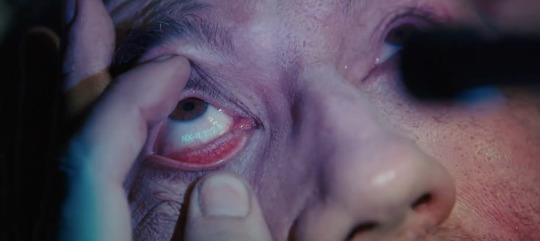
This detail along with some of the tone is a just small parts that show how it was an overall inspiration. The tone especially in some of the general treatment/attitude toward Replikas by those in power will also give that sense.
>The second to last inspiration I really wanted to mention here was 'Alan Wake 2' and whether or not that is a surprise may depend on your personal familiarity with the game/series. This inspiration is a smaller one but in some of the more dream like confusing parts of the story, the way the wording is meant to loop and double back in a way that feels almost poetic was a huge part. Warning for an early 'Alan Wake 2' spoiler (Intended reading for manuscript page written in alt):

Another inspiration that may become clearer later is the general dealing of how a dreamlike perception over reality. Images like this one from the early game live rent free in my head and help me think about how to describe certain abstract things:

Remedy's general handling of this form of weirdness in a visual medium truly is pretty genius and the work of reinterpreting it into writing has been and will continue to be very enjoyable as i expand more on it in the future.
>Final inspiration I very quickly wanted to touch on is 'The King in Yellow' another fairly obvious one, I have an excerpt in the prologue, it appears in the story and in 'Signalis'. The game especially has a lot of references to it. Ahead of really starting writing I read most of the way through the collection of stories, and finished it while I was writing the first couple chapters. I knew from the start I wanted to really lean into some of the general themes of the anthology and though not obvious as if the end of ACT-1, I will continue to. I highly recommend reading it if only to get a greater understanding of some of the ways 'Signalis' references it. I really feel like it puts a lot in perspective. 'The Demoiselle d'Ys' especially, the latter half of that story really gave me a sense of the love and devotion that is put on display in game.
Okay because describing my decisions behind certain concepts and reasonings requires me to go more in detail I'm putting it below the cut because it carries a bit more spoiler-potential than mere inspiration talk. So if you haven't read the fic please go enjoy it here, beware heavy 'Signalis' spoilers though.
Concepts & Reasonings (Beware Spoilers)
>One of the main things I set out from the start to include in the fic was a lot of the 'weird' things that happen in the game. Moments like when you open the butterfly box and suddenly you're on a mountain top, or when you leave the Penrose for the first time at the beginning of the game. This moment, as well as whenever you first encounter a corrupted Kolibri unit always stuck with me as some of the most memorable moments off the game. That's why I wanted to go out of my way to include them, or moments like them. The first was in the second chapter where Falke uses her bioresonance to infiltrate Tempo's mind and is mentally assaulted in a moment where the narrative intentionally twists and loops over itself which ends with this image:
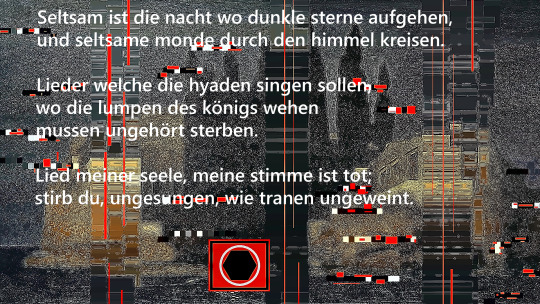
The image is one of the 'Isle of the dead' paintings overlaid with a German translation of an excerpt from the beginning of the 'King in Yellow'. If you want to read you can refer to this post which has the entire excerpt in full in English. This image was one I made in Krita by of course editing the original and mostly adding details to it to fulfill the vibe that is given when you walk into a room with a corrupted Kolibri and it starts getting bad and you can barely see anything, etc... When it came down to actually including it in the text I was a little on the fence, I for one think that images used sparing enough can really emphasize a moment. Much like some of my other decisions, I know it won't work for everyone, but given the intentionally jarring nature I do feel it fits.
>As for how I went about including the vibe of those first person sequences, I wanted it to feel just as alien and initially sudden as the game handled it. This was done by the use of second person, present tense. As I think was beautifully pointed out in a comment on AO3 by @lopadopalis

The intent was exactly that. To contrast not just in perspective but also subtly in tense as well. To give this almost dreamlike quality I think the first-person sections of the game nailed so well. It's enough that if you glaze past it, you won't pick up on it but it may still leave you that off feeling. That in mind using second-person present tense is likely going to be my way of handling these types of moments going forward, as for the same reason as the image in the text, it gives that slight jarring feeling that is exactly what I'm going for. Hidden in here though is a kind of secret influence I didn't mention before and that is 'Harrow the Ninth'.

While its not so much an influence in terms of content, it is an influence in terms of feeling. This books is in my mind the gold standard of second-person narrative, and it's done so well that no other book was able to make me feel as insane as the first few chapters of this book did. And I say that as a compliment. Go read it (after you read the first book in the series ofc).
>Another thing that was mentioned in the comment from Lopadopalis was the death of the Sierpinski survivors. And that is something I do on some level feel the need to explain. In deciding to kill these characters even as most of them are not shown, I felt a great need to do it well. From the start, I knew I wanted to have them decommissioned, and a big part of that was to really show Dr. Lee's true colors even after they made it clear what stance they hold in regards to Replika life. It was startling to have characters that-were they shown in detail-would have been recognizable to anyone who had played the game, and many did seem to recognize the Ara as she appeared. What worried me was that I would accidentally sweep past it too fast. And I hope that isn't the case. Even if mostly referred to as opposed to shown, it carries some impact and does on some level respect them as legacy characters.
>I feel like I keep giving tanks a million times but I really can't stress how much I appreciate @lynxfrost13 for not just allowing me, but also helping me in including the HOPR who I don't know how to link perfectly so I am linking a lore post that was made: here. Please check it out, and also follow Lynx, genuinely without them I'm not sure I would have made my personal deadline. More generally about the HOPR reference around the middle of Chapter 5; I knew I wanted to include other original Replikas as the ones shown in the game aren't the only ones to exist. However, I'm lazy and didn't want to keep coming up with a ton of Replikas that would end up under-cooked because I couldn't give them each the time they deserved. So I made a post and that's when Lynx reached out and we coordinated a way to include the HOPR as a part of the story not just as a character who will be seen more later, but a part of the lore, connections to existing characters and all. I was (and honestly still am) honored to have have been trusted to write with this unit as a part of my story and I'm so glad Lynx had been available to answer any questions and to check over anything and everything to make sure I'm doing their creation justice. ALSO, that need for original Replikas is still ongoing by the way, if you have one and think it may be cool to have it included, send me a DM or ask! I'd love to try and come up with something, the only one that would probably not work is a Schwan Replika, as the Schwan is the one I've planned for the story (if you did do the same as me though still tell me about it! I'd love to hear about your original Replika types!).
>As one of the last things I very briefly wanted to touch on the relationship as it is portrayed in the fic. One of the things that really pushed me past the 'wouldn't that be neat?' stage of planning this fic and into the 'oh shit it's happening' was the kind of lack of very many Falke/Elster/Ariane fics out there. It was my want to see more that partially caused me to start writing. Many other reasons too, but godddd I have to mention that one. Those 3 make me so ill. It was also partially out of wanting to make a work that will get a lot of eyes on it that kinda presents my interpretation of the Sierpinski S23 Falke having Ariane's memories in addition to Elster's. And thus loves Elster as she does Ariane. It just seems like a thing that isn't necessarily a deep-cut theory, but one that is also at least in my opinion not talked about as much as it should be. Though I do feel like it's picked up a lot of traction very recently. I did write a post on this, most that are willing to read this far into this post have probably already read it but I am gonna link it here anyway.
>Okay, this last part is maybe the most interesting section for the purpose of understanding the general scope of ACT-1 and what changes were made in writing that made it what it is now. To anyone who followed me prior to the publishing of ACT-1, maybe even around when I first started talking about the fic, they may know the intent was for this first part of the story to be much bigger, or maybe a better way to say it is more condensed. ACT-1 was meant to encompass nearly all the time the story spent in the Sierpinski facility. The starting intent was to end with the finalization of the new Replika line teased at the end of Chapter 5, and also in the summary. Overall, things would have been pushed together and likely less time given to characters like Dr. Lee to grow into what they eventually became. The decision to change this scope actually came much later prior to posting than is maybe expected. It was around 2 weeks prior to the 27th, I decided (helped along in the decision by my girlfriend) to make the first ACT what it is now, and expand what was initially 3 chapters into a whole 4 then but now 5. This decision was made not just due to the anniversary growing closer and my concern about missing it, but also because I kept wanting to add more. Chapters began to balloon in length as they became closer to what they now are. It hit a point that, eventually, I had to look at what I had and admit it had far outgrown the initial scope. Deciding then it worked better as the new ACT-1 than all of the time in Sierpinski together. Looking back having posted it, I stand by this decision. This allowed Dr. Lee to bloom into a the character they are now and make the reveal that was their change in demeanor better overall. It also allowed me to expand on some of the aforementioned weirdness moments, the entire section with the Falke looking into Tempo's mind in Carcosa was only a few sentences in that first draft. Lastly it also allowed the build up to where Falke ends up this first draft to feel much better telegraphed and overall better earned; her situation is more believable when more is shown and what that extra space allowed me to set up makes for better moments in the future too!
AND THAT'S THE POST! It's a fuckin big one, but then again there was a lot to talk about. Hopefully this really shows that I mean when I say how much love went into this fic, and how much continues to as it goes on. From fanart (some that's even yet to be released), to incorporating my own enjoyments and personal writing inspirations, even just making the hard decisions so what I make is something I'm proud of. If you read the fic, thank you so much, from the bottom of my heart. And if you read all the way through this monster of a post, then I really appreciate your dedication to my brain-rot.
#signalis#in the shadow of sierpinski#my writing#writing#nightly speaks#ariane yeong#falke signalis#falke posting#BIG ASS POST#elster signalis#lstr 512#if u read the whole thing thank you so much i owe you my life
9 notes
·
View notes
Text
So I don't know how this happened, but after years and years of trying to write a book and abandoning everything I ever attempted because I couldn't get through even one completed first draft, I finally finished one way back in 2018 or 2019. Even more shocking, I managed to get through several rounds of editing with the story still in one piece. Then I got it to a point where I felt like it was as good as I could really get it without soliciting any feedback. So I posted it on Critique Circle and after all my feedback came in and I'd done a few more revisions I got it to a point where I actually thought it was polished enough to start looking into publishing. It was sometime in March or May of 2020 I think when I sent out my first queries to about 4 or 5 agents and I was shocked that one of them actually requested a full. I was expecting dozens of flat rejections or non-replies before seeing even a kernel of interest.
While waiting to hear back from the agents I'd queried I tried working on a few different stories, but then I started thinking about a bunch of things that were bugging me about my book and getting new ideas I thought would improve it greatly. So I decided not to query anymore agents and instead start a new round of revisions. Based on how the writing and revision process for me had been before, I was expecting this to take me maybe a month or two. But somehow it's been FIVE FUCKING YEARS and I still haven't gotten through even one single completed new draft.
I'm sure part of it is that the pace I was working at slowed down dramatically because during that 1-2 months I was waiting to hear back from agents I broke the habits I used to have to maintain a steady, reliable flow of productivity and it took me an excruciatingly long time to pick them up again.
But I think mostly the reason for all that time vanishing and leaving me with nothing to show for it is that I did the same thing I always do where I keep coming up with new ideas, but to implement them I have to go back and start weaving them into the narrative from Chapter 1, and half the time those ideas don't even stick and I go back to what I had before or replace them with something else. And regardless of whether it's a big change that requires massively rewriting or throwing out entire chapters or just altering, removing, or inserting a few lines here or there in a couple of chapters, I still ultimately end up disatisfied because there's still a ton of stuff that I don't like that none of these changes ever actually seems to solve. There's still scenes I want to throw completely out but I can't figure out what I could have happen instead to accomplish the same thing. There's still plot points that are vital to the story but I don't know how to make them happen in a way that doesn't feel contrived without having to add a lot of detail that has to be explained in a lengthy monologue. I keep wanting to add more detail to make everything feel really fleshed out and fully realized and thought through but I still want the story to feel simple and streamlined and not overly-complicated.
So the current status of my book is that it's in a million pieces and it feels like there's no end in sight to this fruitless quest to put it back together again. And this is a feeling I'm used to experiencing with every other story I ever worked on, which ultimately led to me giving up on it and trying something else. And I thought this time it would be different because the experience of writing it initially felt really different. A lot of it came together very naturally and the pieces fit together better than I imagined. The fact that I actually managed to finish the story and revise it as many times as I did and still have it end up in one piece, and actually showed it to other people was just leaps and bounds beyond anything I'd ever accomplished before. I used to look at my folder full of story ideas and get exited about the next one I wanted to write because I thought finishing one story meant I could finish others. But now when I look at that folder I just imagine myself ending up here again, right back where I always end up, unable to finish anything because there's always a million little problems I can never figure out how to fix, so it feels pointless to even try anymore.
3 notes
·
View notes
Note
Hey, Yep! Have you ever had writer's block? And if so, how did you break it?
Hey, Arty! 💜
Oh, definitely. 😅 No writer is safe from the dreaded state of "writer's block," but I do have some tactics I use to get through it...
5 Tips for Beating Writer's Block
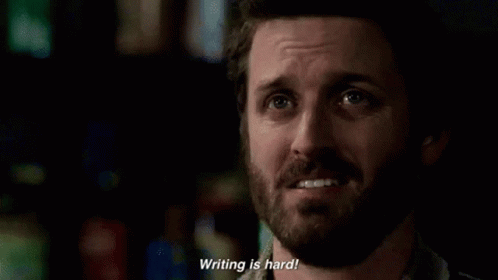
Start plotting with an outline. ✍🏽
There are two kinds of writers, in my opinion:
Architects: writers who outline.
Adventurers: writers who freeform.
In most respects, I consider myself an Architect. My brain craves structure. So the way I beat writer's block while working on a project is by having a roadmap of what's going to happen next. That's thanks to my outline.
Even freeformers can develop some kind of pre-writing plan, whether that's creating a list of character bios, starting with the basic 3-Act triangle, or writing out a handful of bullet points to get you going.
For my personal process, I'll go from creating the basic premise/summary, to some loose bullet points of the story structure, to then fleshing out into full outlining of each chapter and scene, and finally drafting (and editing).
While I'm outlining, I'm also doing research and fact-checking as needed to get me through to the next scene and the next, until the end. My "roadmap" tends to be very detailed, so when I get to the drafting part, all I should have to reference is my outline.
Now, this doesn't mean that plot points won't change, or get switched around, or get chucked entirely. But if I have the blueprints of the house, I can change a window or a door, or even a whole support beam here and there, so to speak.
2. If I get stuck at any point during the outlining and/or drafting phase, I'll often go back and reread what I have already. 🧐
I'll edit and tweak as I do those readthroughs, whether it's my outline or drafted chapters. It freshens up the earlier scenes and plot points in my head.
In doing so, it'll hopefully unlock ways I can continue the later plot points, and even tie them back to things I'm setting up earlier in the narrative.
3. Revisit the thing that gave you inspiration in the first place! 🍿
Rewatch, reread, revisit the episode, movie, book, story, artwork that stroked your muse and had you daydreaming and brainstorming about the WIP you're working on. That can be a good way to revitalize you when you feel you're getting stuck on something in a plot point, or lacking motivation.
4. Create a music playlist. 🎶
I love doing this, especially for a series. I often create a playlist of songs that remind me of the setting, the characters, the overall story, or the romance I'm trying to create. Whether it's the words or the tone/rhythm that get me going, music inspires me greatly.
5. Go for a walk. ☀️
I walk for exercise, but it also gives me time to daydream and run through scenes in my head while vibing to my music (sometimes looking like a crazy person as I nod and make hand motions lmao).
This helps me clear my head, get some fresh air, then come back to my laptop with a little more pep in my brain, ready to pick up where I left off while writing. 👌🏽

Thank you so much for this question, @artyandink! (Sorry, meant to tag you when I originally posted.) I hope these ideas help you beat writer's block. 💕 Let me know if you have any additional questions!
#ask me stuff#writer's block#on writing#writing process#writing stuff#creative writing#lovely mutuals#my writing process#supernatural#supernatural fanfiction#the boys#the boys fanfiction#big sky#big sky fanfiction#dean winchester#beau arlen#soldier boy#soldier boy fanfiction#beau arlen fanfiction#dean winchester fanfiction#sam winchester#sam winchester fanfiction#zepskies answers
15 notes
·
View notes
Text
today's May 21st, it's Rapture Day! my story is 14 years old now.
I don't have anything to show for it, I've still been focused on The Other Thing, which is.. I mean, it's really close, I still plan on releasing it this month. and it does at least have a tangential relation to Rapture.
the final draft of Rapture should resume sometime in the second half of this year, though I guess it's always possible it won't. truthfully, Rapture is a hard story to write, and not all of that difficulty even comes from its actual format.
to write Rapture, and especially to make changes to it, means digging into some old self-reflections from around that time. 14, 13, 12 years ago, when I was going from a teenager to an adult, trying to honestly assess my life and my role within it, whether I had been a Good Person or not, what patterns and flaws held me back and could be changed, and whether or not those flaws were wise to depict so publicly in a story I was pushing hard.
that kind of self-reflection, carefully curated to look as bare as possible (to the point where I often would accidentally reveal things about myself I didn't even know were a thing, and so Rapture ended up teaching me about myself), well yes that's the kind of Modern Art I had wanted Rapture to be, the kind of Public Performance, and the thing that I believed set Rapture apart from other Internet Fiction. the fact that I was able to reach the end of the story back in those days isn't even a Miracle, it's a testament to where I was in my life, I chose Rapture over the world around me at times because I needed something to cling to. I might have been able to make some better choices in my life back then if I hadn't been writing Rapture. but there was also no way I wasn't gonna write Rapture at that time. I was chasing the Public Performance part of it for a reason, something about.. having to raise myself, teach myself lessons that my role models weren't able to teach me. I was becoming an adult, and I needed something to show for it. without a dad who'd teach me appropriate life lessons, without a mum who'd prepare me for the world, without schooling to give me routine and networking and motivation, I had to try and make myself an adult. based only on my feeble ideas of what an adult is.
this shit hurts to think back on. I've been waking up with some overwhelming fear recently, getting some memories back that I'd otherwise been numb to for a while. I've managed to come to terms with the more violent memories, the things my role models had done to me, and whether or not I deserved that treatment. but what's proven much more difficult to process has been the consequences of those impulses I had, to be a public artist in order to raise myself. my inability to appropriately provide for myself, and my seeking substitutes without a true understanding of.. human beings. the choices I made are what haunt me. I can never know how much of my alienation is my own fault. I can never know how many people I've actually hurt over the years. and I have no idea what I'm supposed to do with the information, whether I have it or not. there is no social conditioning in me for that, no past experience of my dad, an older brother, or schoolfriends demonstrating that. not except for "apologize and then leave you alone, forever."
those choices I've made in my life, they necessarily don't end up in Rapture. I may translate some of them into the story, and it's inevitable that everything ends up driving the narrative indirectly (I can point to every single plot point in Act 4 and tell you what actual happenings influenced the tone), but overall the contents of Rapture are fictional, often much simpler conflicts than real life gives me.
anyway. getting through Act 2 in the final draft was one thing-- it took me two months of crunch, and towards the end I discovered a much more mature reflection on the isolation motif that I've not found a satisfying resolution for yet-- but the story only gets harder as we go. Act 3 has a pronounced downward emotional trend, which was originally tied into a Love Triangle plot that I have every desire of reworking this time (what are the conflicts underneath that led to that in the original draft? I can take out the Love Triangle altogether if I can find the emotional core), and.. these are questions that were much easier to ask myself back when I was much younger! I'm in a more stable position in my life now (I have things to Lose!), but I still don't really have a huge support system, and digging into Rapture is going to destabilize me somewhat. it's an intimidating prospect.
maybe the truth is I'm just not very good at writing Normal narratives, and I always have to base my stories on something deeply personal.
but. hey. look.
Rapture Day.
it marks the start of five months, lasting until the other Rapture Day on October 21st.
it's not common for this five-month period to actually mean anything substantial, but I mark it every year out of hope. my most magic creative periods have always come during this time of year, and every year I have hope that I'll get another one. because summer sucks, and I respond to the heat by stubbornly expressing myself.
the five months of Rapture are when I end up feeling like I should be doing something. this is the only time of the year that that feeling is consistent.
but hey. hey hey.
okay it's somehow only now sinking in that it's Rapture Day. and that I love being DJay. that is, I love Creating For The Internet.
and remember, I may not have any new Rapture for you, but I do still have something in the works! something that is imminent, and it has a roughly... 9-hour runtime! and that's not counting all the reading portions!
you heard me right! 9 hours! even those of you who've been keeping track of my tumblr posts and know what the next project is will be like "wait it should only be like.. 7 hours max."
not only are those 7 hours you're already familiar with MADE NEW AGAIN, but there's an ADDITIONAL 2 HOURS!!!
motherfucker, I've been busy this last two months. I've put in a Rapture amount of work into this.
and, on this Rapture Day, let that be the positive takeaway. no matter what becomes of the story, Rapture has had that legacy: it's transformed into an ideal, as well as an aesthetic.
so hey. happy rapture day, everybody. you can look forward to Something Big from me soon, but in the meantime, I'll leave you with a piece of Rapture art that's quite general.
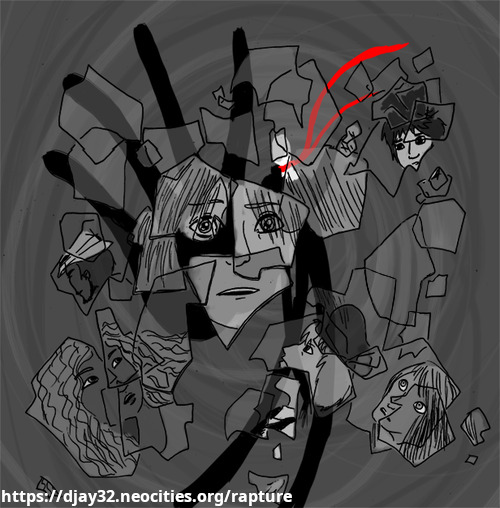
6 notes
·
View notes
Text

I've been working on my Antichrist OC's character file as I drink my morning coffee, and... WHAT WAS THE NOTE SUPPOSED TO BE?! 😅
It has been sitting in my drafts for ages, and, really the main issue tripping my up is the vehicle she uses to take over the world. I thought about the UN, but I don't want it to be the UN. I use that trope in my original story, and I want to maintain differences between this Antichrist and that one. Besides, I may need to bring it into Omen-related fics even if the real Antichrist is Layla and not Damien, because The Final Conflict brought it in. Now, my other option was... NATO. Or, at least, it would be the starting point, and when Max takes over, it grows into a worlwide alliance with a different name, and eventually an Empire (I don't want to use the Roman Empire specifically even though it's the traditional trope, because of aforementioned story differences). Unfortunately, I'm VERY dubious and anxious about it.
1. It has to do with my (severe) OCD, which I will not elaborate on, because I have no intention to reveal my sore spots to the internet.
2. I will be accused of being Anti-NATO, and imperialist. It's not true, I, the author, am Eastern European, and the most pro-NATO, anti-imperialist person you could imagine. This would be a fictional story, that takes certain real-life elements to create a fictional narrative.
3. If you're a pro-NATO, why would you put a villain in charge? I, the author, also am a real-life Satanist. Satan is not a villain to me. The Antichrist is not the villain to me. Now, someone may say, but you're anti-imperialist... Yes. Max is not the villain. She's not the good guy, either. She's a complex, morally grey character who loves humankind, but will take any means to achieve her goals. Her story, or rather any of them, is also not meant to reflect my political or moral worldview. It's meant to be it's own, fictional world, a fantasy where things that can never work in real life (such as a world empire) can be explored.
So maybe, I should do it... I mean, it would be cool to have a female secretary-general, even if fictional. Also, the only way to battle ocd is to go directly against what it tells you. But... I don't know. A lot of world domination, she achieves via diplomacy and Infernal meddling, but there would be military conquests. Again, for variety, for differences from my original story, and also, because one of Max's main love interests is War from Good Omens. I love her character, and I want her to shine.
No, maybe I should not bring NATO in, it's too sore a spot, and may cause too many potential misunderstandings. Thing is, I'm set on Max's vehicle for world domination being a military alliance. I thought, if I take from the real world anyway, I should use real structures in it, but... Maybe not? Maybe, when Max takes over as Secretary for Foreign Affairs, she begins to form a new alliance through diplomacy and Infernal meddling, which eventually absorbs existing structures, and the whole world. I think, that's better, yeah. 💡I can avoid triggering my anxiety and paranoia, and I can avoid the misunderstandings. Now, I just need a name.
One may ask, if I figured it out, what's the purpose of me posting this? I don't know, I like keeping a sort of diary of my writing process?.. Besides, like I said, I have severe ocd. I'm trying to combat it, by doing what it forbids me to do. Since I'm not doing what I'm afraid of doing in the story (well, I'm not sure yet, maybe as the *new alliance* grows, she'll be made Secretary General, except it won't be that significant of a plot point), I'm at least talking about what I'm afraid to bring up. Besides, this kind of helped me remember what the note was supposed to be about, namely how the story has zero to do with the real world, real history and current events, so don't bring any of it up? and how the narrative is not a reflection of the author's moral/political values. 😇
Damn, I still have a lot of work on this. Maybe, I could draw a better picture of her meanwhile...
Maybe, based on this picture, it's very Max-coded.

Or this one (but it's too casual) 😬

Or, just try again with the original one...

I kind of fear her face looks puffy in the one you see the hem of. I'm also not sure whether I should try listing her powers, she has a lot, maybe just some of them... And, I'm not yet sure abouf her tattoos, I want her to have three, but I can't firmly decide what of.
Speaking of WarBeast, it's kind of hilarious. I keep the real height of the actresses, meaning, War is SO TINY compared to Max. 🤣
(Why am I saying Max is not the good guy, she's the voice of reason despite being a functional alcoholic, and continuously prevents Archangel Michael from slaughtering (more) innocent people)
#diary pages#for real... like i bare my bones in this entry and i haven't taken my meds yesterday so i'm extra anxious#writing journal#oc#my ocs#oc files#maxine frost#the antichrist#ocd#actually ocd#max my beloved#the first omen made such an impact on me nell is not the antichrist too#warbeast#work in progress#i need to complete this for once#i mean chthylla's bio awaits#also i can't upload my notes on my version of good omens without both of their bios#horror oc#antichrist myths#good omens oc#sophia frost#tagging because of the character's name change
2 notes
·
View notes